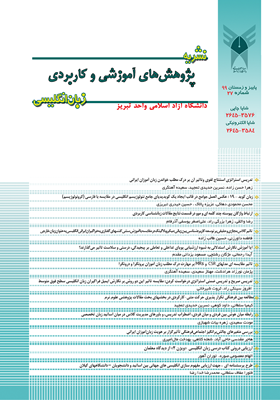Connecting Formulaic Sequences and Moves in Applied Linguistics Research Article Results
الموضوعات :رضا واثقی 1 , زهرا بزرگی راد 2 , علی اصغر یوسفی آذرفام 3
1 - گروه انگلیسی ، واحد آیت ا... آملی، دانشگاه آزاد اسلامی ،آمل، ایران
2 - گروه انگلیسی، واحد آیت ا... آملی،دانشگاه آزاد اسلامی ، آمل، ایران
3 - گروه انگلیسی ، واحد صوفیان، دانشگاه آزاد اسلامی ،صوفیان، ایران
الکلمات المفتاحية: Applied Linguistics, formulaic clusters, move analysis, research article result section,
ملخص المقالة :
The current research examined the use of lexical bundles in the result sections of research papers by Iranian non-native writers in the field of applied linguistics. The WordSmith Software was applied to identify lexical bundles. In addition, the two analytical frameworks Biber et al. (2004) and Ruiying and Allison (2003) were used to categorize the bundles with regard to their structural features and their moves and steps. Moreover, with the aid of concordance, the identified clusters were analyzed and categorized according to their communicative functions. The results of the current research showed that Iranian writers relied heavily on the use of specific formulaic bundles to perform the communicative functions associated with the moves and steps. The findings also revealed that four moves out of six moves were mostly used by Iranian authors. Moreover, the researchers found that the extensive range of formulaic clusters used to demonstrate Move 2, Reporting results, the least bundles occurred in Move 4, Summarizing results, and also no clusters were used in Move 5, Evaluating the study along with Move 6, Deductions from the research by Iranian writers. The findings of this study boost the awareness of formulaic sequences usage for novice writers in particular discourse and communicative function.
Ädel, A., & Erman, B. (2012). Recurrent word combinations in academic writing by native and non-native speakers of English: A lexical bundles approach. English for Specific Purposes, 31(2), 81–92. https://doi.org/10.1016/j.esp.2011.08.004
Amirian, Z., Kassaian, Z., & Tavakoli, M. (2008). Genre analysis: An investigation of the discussion sections of applied linguistics research articles. The Asian ESP Journal, 5(2), 1–120.
Bamberg, B. (1983). What Makes a Text Coherent? College Composition and Communication, 34(4), 417. https://doi.org/10.2307/357898
Bhatia, V. K. (2004). Interdiscursivity in critical genre analysis. In: BONINI, A.; FIGUEIREDO, D. C.; RAUEN, F. (Orgs.). Proceedings from the 4th International Symposium on Genre Studies (SIGET). Tubarão: Unisul, 2007. v. 1. p. 391-400. Disponível em: <http://www3.unisul.br/paginas/ensino/pos/linguagem/cd/English/36i.pdf>.
Biber, D., & Barbieri, F. (2007). Lexical bundles in university spoken and written registers. English for Specific Purposes, 26, 263–286. https://doi.org/10.1016/j.esp.2006.08.003
Biber, D., Conrad, S., & Cortes, V. (2004). If you look at: Lexical bundles in university teaching and textbooks. Applied Linguistics, 25(3), 371–405. Retrieved from http://applij.oxfordjournals.org/content/25/3/371.short
Biber, D., Johansson, S., Leech, G., Conrad, S., & Finegan, E. (1999). Longman grammar of written and spoken English. Harlow: Longman.
Cortes, V. (2004). Lexical bundles in published and student disciplinary writing: Examples from history and biology. English for Specific Purposes (10), 23(4), 397–423. https://doi.org/10.1016/j.esp.2003.12.001
Cortes, V. (2013). The purpose of this study is to: Connecting lexical bundles and moves in research article introductions. Journal of English for Academic Purposes, 12(1), 33–43. https://doi.org/10.1016/j.jeap.2012.11.002
Gledhill, C. J. (2000). Collocations in science writing. Retrieved from https://www.academia.edu/1997042/Collocations_in_Science_Writing
Hyland, K. (2008). Genre and academic writing in the disciplines. Language Teaching, 41(04), 543–562. https://doi.org/10.1017/S0261444808005235
Kanoksilapatham, B. (2007). Writing scientific research articles in Thai and English: Similarities and differences. Silpakorn University International Journal, 7, 172–203.
Lim, J. M. H. (2006). Method sections of management research articles: A pedagogically motivated qualitative study. English for Specific Purposes, 25(3), 282–309. https://doi.org/10.1016/j.esp.2005.07.001
Marco, M. J. L. (2000). Collocational frameworks in medical research papers: A genre-based study. English for Specific Purposes, 19(1), 63–86. https://doi.org/10.1016/S0889-4906(98)00013-1
McCulley, G. A. (1985). Writing Quality, Coherence, and Cohesion. Research in the Teaching of English, 19(3), 269–282. Retrieved from http://www.jstor.org/stable/40171050%5Cnhttp://about.jstor.org/terms
Musa, N. F., Khamis, N., & Zanariah, J. (2015). The structure of method section in engineering research articles. Asian Social Science, 11(17), 74–82. https://doi.org/10.5539/ass.v11n17p74
Nwogu, K. N. (1997). The medical research paper: Structure and functions. English for Specific Purposes, 16(2 SPEC. ISS.), 119–138. https://doi.org/10.1016/s0889-4906(97)85388-4
Peacock, M. (2002). Communicative moves in the discussion section of research articles. System, 30(4), 479–497. https://doi.org/10.1016/S0346-251X(02)00050-7
Phuong Dzung Pho. (2008). Research article abstracts in applied linguistics and educational technology: a study of linguistic realizations of rhetorical structure and authorial stance. Discourse Studies, 10(2), 231–250. https://doi.org/10.1177/1461445607087010
Ruiying, Y., & Allison, D. (2003a). Research articles in applied linguistics: Moving from results to conclusions. English for Specific Purposes, 22(4), 365–385. https://doi.org/10.1016/S0889-4906(02)00026-1
Ruiying, Y., & Allison, D. (2003b). Research articles in applied linguistics: Moving from results to conclusions. English for Specific Purposes, 22(4), 365–385.
Saber, A. (2012). Phraseological patterns in a large corpus of biomedical articles. Corpus-Informed Research and Learning in ESP: Issues and Applications. Amsterdam: John Benjamins Publishing Company, 45–82.
Samraj, B. (2002). Introductions in research articles: Variations across disciplines. English for Specific Purposes, 21(1), 1–17. https://doi.org/10.1016/S0889-4906(00)00023-5
Sandoval, M. (2010). Stance-taking strategies in the written discourse of research papers conclusion sections. In First International TESOL Convention, Clark Freeport Zone, Philippines Retrieved from http://independent.academia.edu/MarlowieSandoval/Papers/407379/Stancetaking
Schmidt, R. W. (1990). The role of consciousness in second language learning. Applied Linguistics, 11(2), 129–158. https://doi.org/10.1093/applin/11.2.129
Swales, J. (1990). Genre analysis: English in academic and research settings. Cambridge University Press.
Thompson, D. K. (1993). Arguing for Experimental “Facts” in Science: A Study of Research Article Results Sections in Biochemistry. Written Communication, 10(1), 106–128. https://doi.org/10.1177/0741088393010001004
Williams, I. A. (1999). Results Sections of Medical Research Articles:: Analysis of Rhetorical Categories for Pedagogical Purposes. English for Specific Purposes, 18(4), 347–366.


